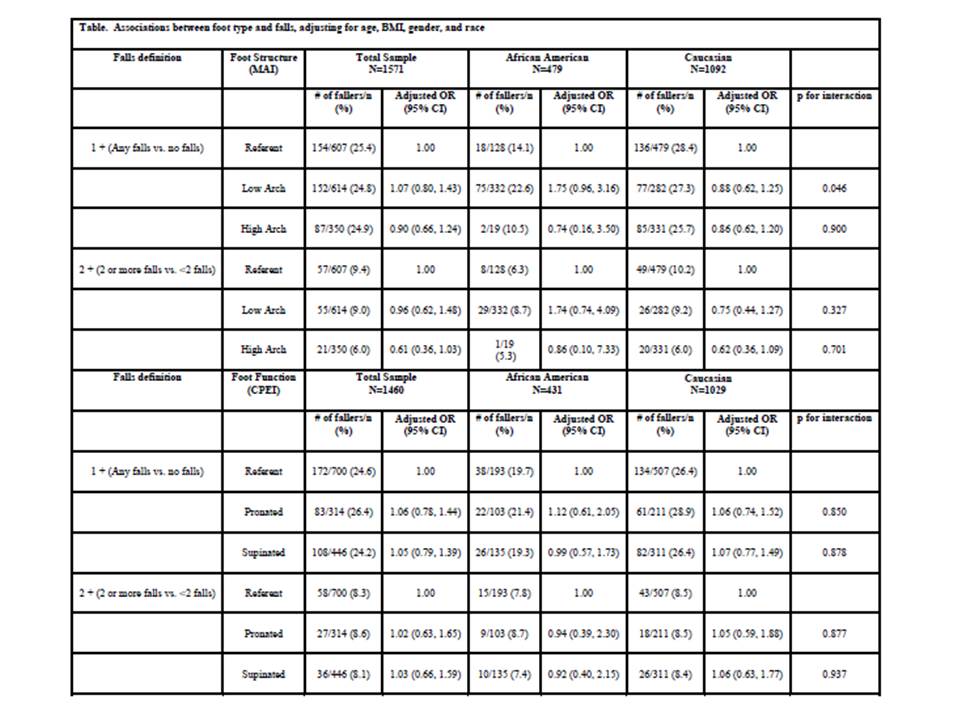Session Information
Session Type: Combined Abstract Sessions
Background/Purpose: Nearly 1/3 of older adults experience at least one fall annually in the United States. Foot type (static and dynamic arch height) is related to how people walk, but the relationship to falls is unclear. Prior studies have shown differences in foot type by race with a lower arch height more common in African Americans than Caucasians. The purpose of this cross-sectional study was to evaluate the association of static foot structure and dynamic foot function with falls in a community-based study of Caucasian and African American men and women 50+ years old.
Methods: Participants in the Johnston County Osteoarthritis Project were queried: “In the last 12 months, have you had any falls of any type?” If they answered “yes”, the number of falls was reported. Tekscan Matscan foot pressure scans were used to determine foot structure (modified arch index [MAI]) during standing and foot function (center of pressure excursion index [CPEI]) while walking. Foot structure (high arch ≤0.030, low arch ≥0.164, referent >0.030 and <0.164) and foot function variables (pronated ≤7.3, supinated ≥21.0, referent >7.3 and <21.0) were defined a priori (based on quintiles from population data), and the most extreme foot type for each participant was used in analyses. Logistic regression models were used to estimate the association between foot types and falls (defined two ways as ≥1 fall and ≥2 falls), adjusting for the covariates of age, body mass index [BMI], gender, and race. Statistical interaction between foot types and each covariate was examined, and p<0.10 was considered statistically significant.
Results: Of the 1690 participants with complete falls data, 1571 participants had foot structure data and 1490 had foot function data (mean age 68 ±9 years, mean BMI 31 ± 7 kg/m2, 67% women, 30% African American). 25% of participants reported 1+ falls in the past 12 months and 8% reported 2+ falls. Although not statistically significant (p=0.06), the odds of 2+ falls were 40% lower among participants with high arches compared to referent (Table). The interaction between low arches and race was p=0.05, and thus results were stratified by race. African Americans had a lower occurrence of falls than Caucasians. Among African Americans, those with low arches had a 75% higher odds of 1+ falls compared to referent, although these results were of borderline significance (p=0.07). Foot function was not associated with falls (Table).
Conclusion: These cross-sectional results indicate a possible protective relationship between high arches and falls and among African Americans a positive association between low arches and falls. Future studies are needed to longitudinally examine the role of foot type in falls and to test the effectiveness of interventions for modifying foot type (e.g., orthotics) for fall prevention in populations.
Disclosure:
Y. M. Golightly,
None;
M. T. Hannan,
None;
H. J. Hillstrom,
JAK Tool,
5;
A. B. Dufour,
None;
A. E. Nelson,
None;
A. Dore,
None;
J. M. Jordan,
Trinity Partners, Inc. ,
5,
Osteoarthritis Research Society International,
6,
Chronic Osteoarthritis Management Initiative of US Bone and Joint Initiative,
6,
Samumed,
5,
Interleukin Genetics, Inc. ,
5,
Algynomics, Inc. ,
1.
« Back to 2013 ACR/ARHP Annual Meeting
ACR Meeting Abstracts - https://acrabstracts.org/abstract/the-link-of-foot-structure-and-foot-function-with-falls-the-johnston-county-osteoarthritis-project/

